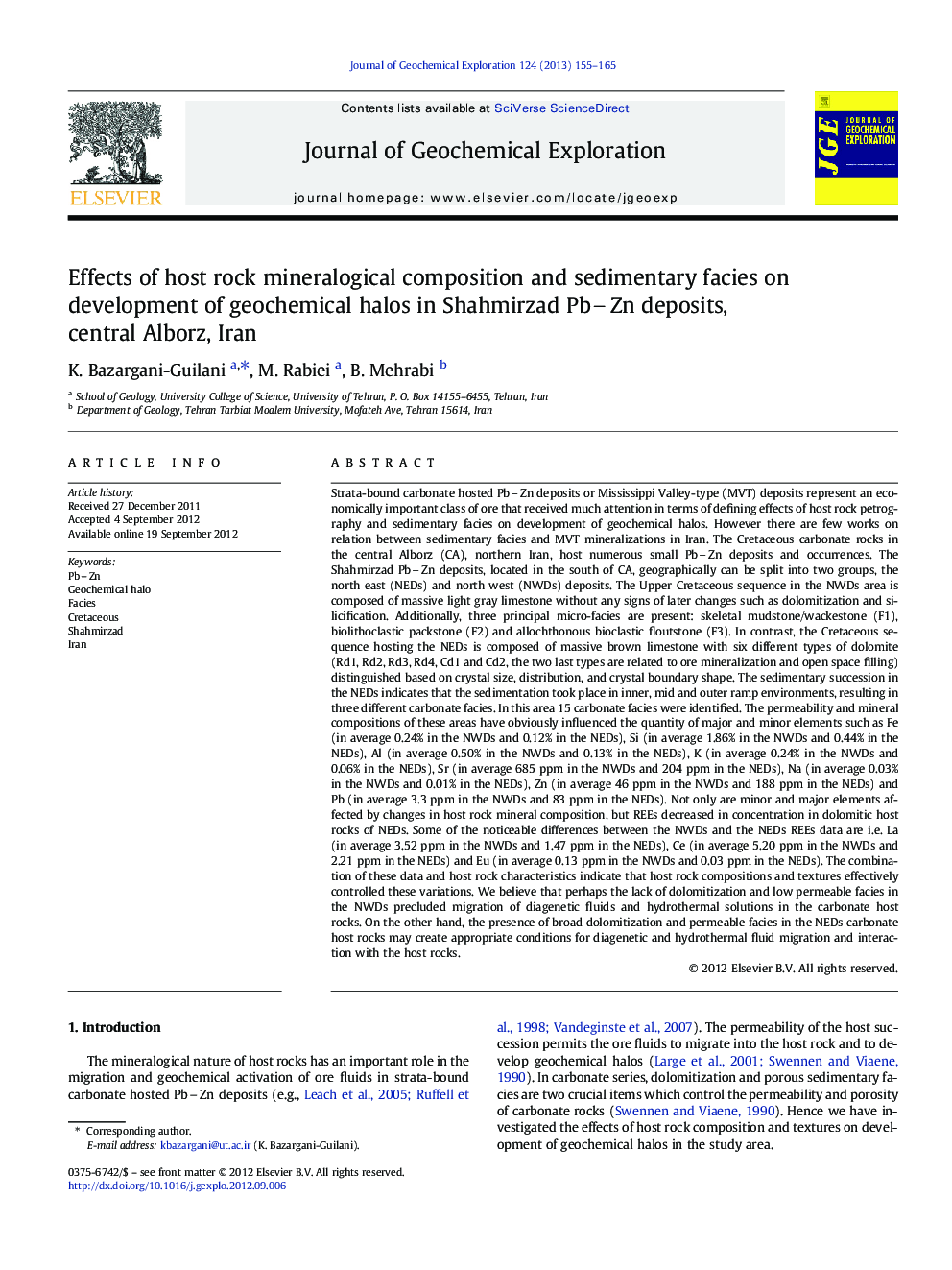| کد مقاله | کد نشریه | سال انتشار | مقاله انگلیسی | نسخه تمام متن |
|---|---|---|---|---|
| 4457688 | 1620932 | 2013 | 11 صفحه PDF | دانلود رایگان |

Strata-bound carbonate hosted PbZn deposits or Mississippi Valley-type (MVT) deposits represent an economically important class of ore that received much attention in terms of defining effects of host rock petrography and sedimentary facies on development of geochemical halos. However there are few works on relation between sedimentary facies and MVT mineralizations in Iran. The Cretaceous carbonate rocks in the central Alborz (CA), northern Iran, host numerous small PbZn deposits and occurrences. The Shahmirzad PbZn deposits, located in the south of CA, geographically can be split into two groups, the north east (NEDs) and north west (NWDs) deposits. The Upper Cretaceous sequence in the NWDs area is composed of massive light gray limestone without any signs of later changes such as dolomitization and silicification. Additionally, three principal micro-facies are present: skeletal mudstone/wackestone (F1), biolithoclastic packstone (F2) and allochthonous bioclastic floutstone (F3). In contrast, the Cretaceous sequence hosting the NEDs is composed of massive brown limestone with six different types of dolomite (Rd1, Rd2, Rd3, Rd4, Cd1 and Cd2, the two last types are related to ore mineralization and open space filling) distinguished based on crystal size, distribution, and crystal boundary shape. The sedimentary succession in the NEDs indicates that the sedimentation took place in inner, mid and outer ramp environments, resulting in three different carbonate facies. In this area 15 carbonate facies were identified. The permeability and mineral compositions of these areas have obviously influenced the quantity of major and minor elements such as Fe (in average 0.24% in the NWDs and 0.12% in the NEDs), Si (in average 1.86% in the NWDs and 0.44% in the NEDs), Al (in average 0.50% in the NWDs and 0.13% in the NEDs), K (in average 0.24% in the NWDs and 0.06% in the NEDs), Sr (in average 685 ppm in the NWDs and 204 ppm in the NEDs), Na (in average 0.03% in the NWDs and 0.01% in the NEDs), Zn (in average 46 ppm in the NWDs and 188 ppm in the NEDs) and Pb (in average 3.3 ppm in the NWDs and 83 ppm in the NEDs). Not only are minor and major elements affected by changes in host rock mineral composition, but REEs decreased in concentration in dolomitic host rocks of NEDs. Some of the noticeable differences between the NWDs and the NEDs REEs data are i.e. La (in average 3.52 ppm in the NWDs and 1.47 ppm in the NEDs), Ce (in average 5.20 ppm in the NWDs and 2.21 ppm in the NEDs) and Eu (in average 0.13 ppm in the NWDs and 0.03 ppm in the NEDs). The combination of these data and host rock characteristics indicate that host rock compositions and textures effectively controlled these variations. We believe that perhaps the lack of dolomitization and low permeable facies in the NWDs precluded migration of diagenetic fluids and hydrothermal solutions in the carbonate host rocks. On the other hand, the presence of broad dolomitization and permeable facies in the NEDs carbonate host rocks may create appropriate conditions for diagenetic and hydrothermal fluid migration and interaction with the host rocks.
► We compared geological and geochemical features between two MVT mineralized areas.
► We recognized differences between host rock permeability.
► Permeability helped circulating fluid to form various geochemical halos.
► Permeable rocks helped circulating fluid to effect ore grades and tonnages.
► Results demonstrate host rock permeability as an effective geochemical exploration tool.
Journal: Journal of Geochemical Exploration - Volume 124, January 2013, Pages 155–165